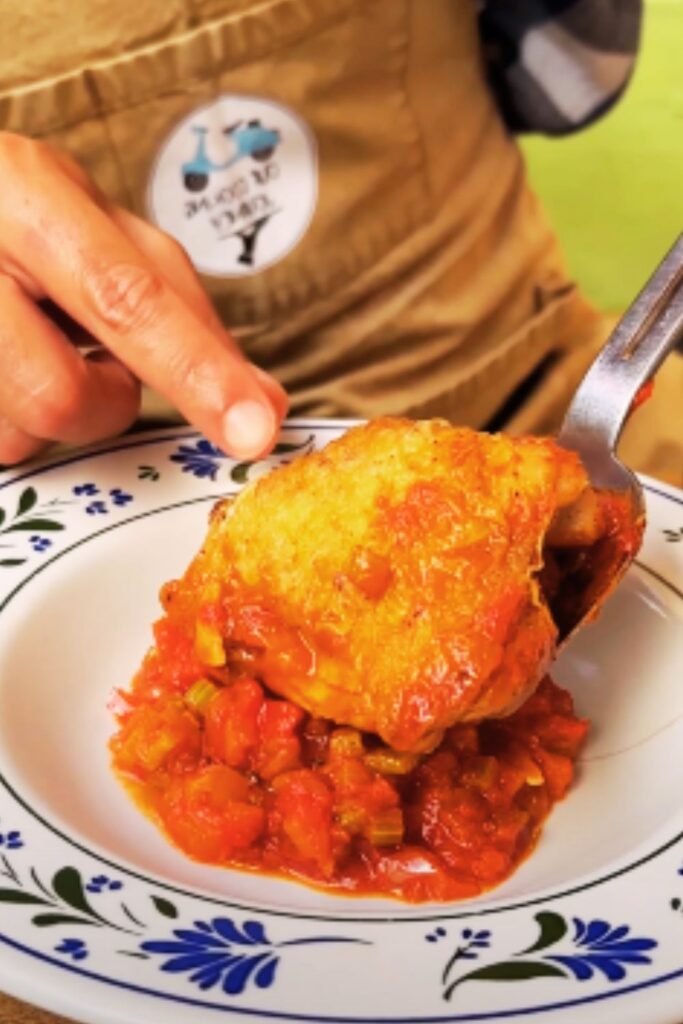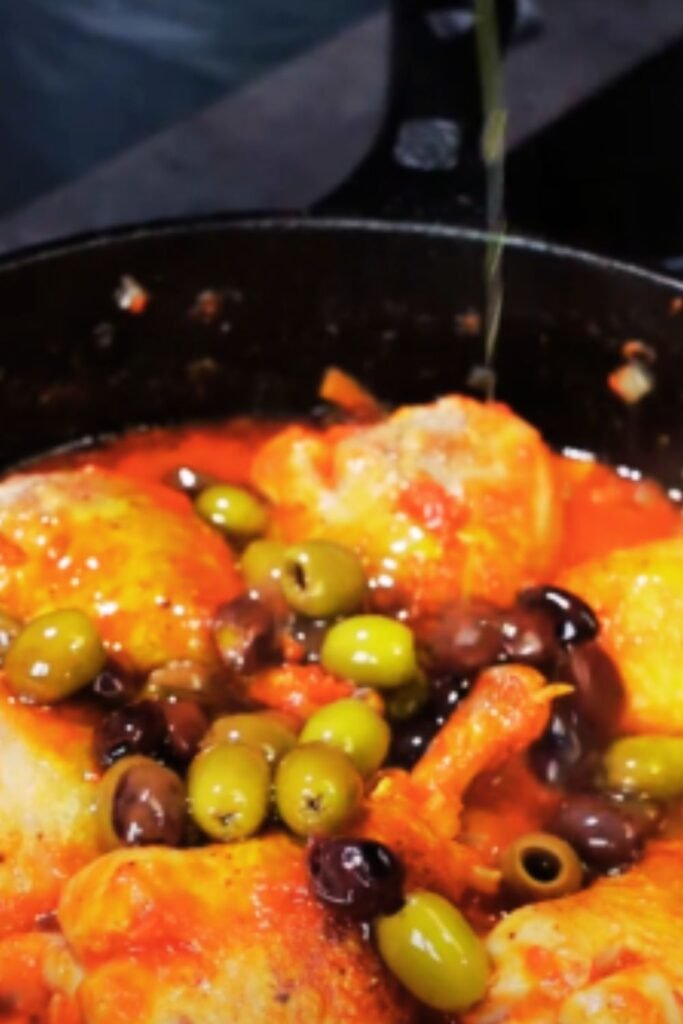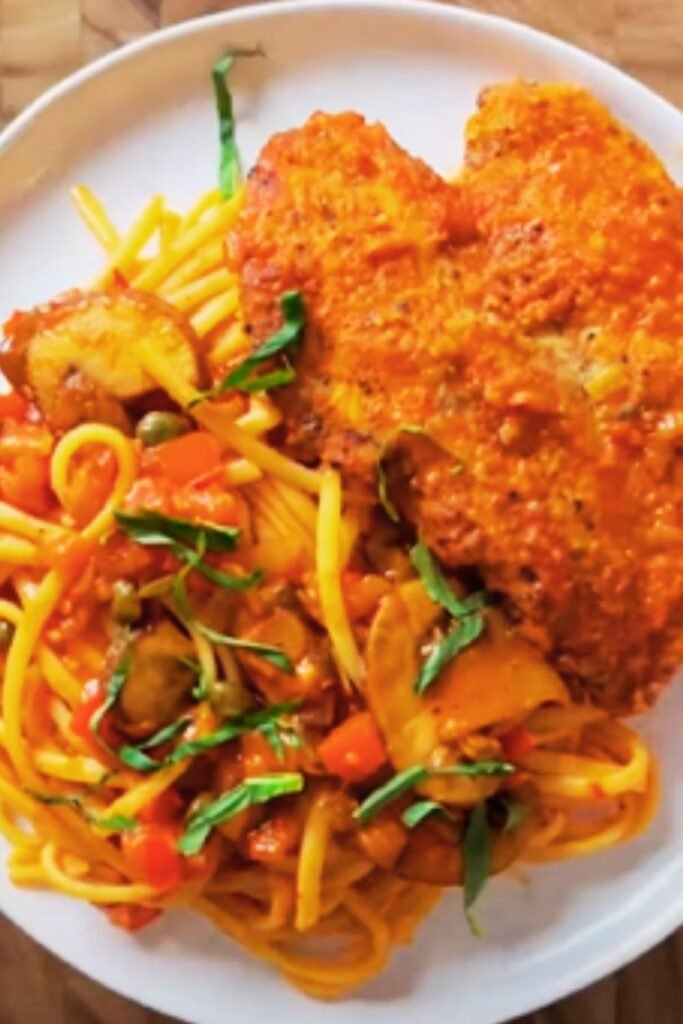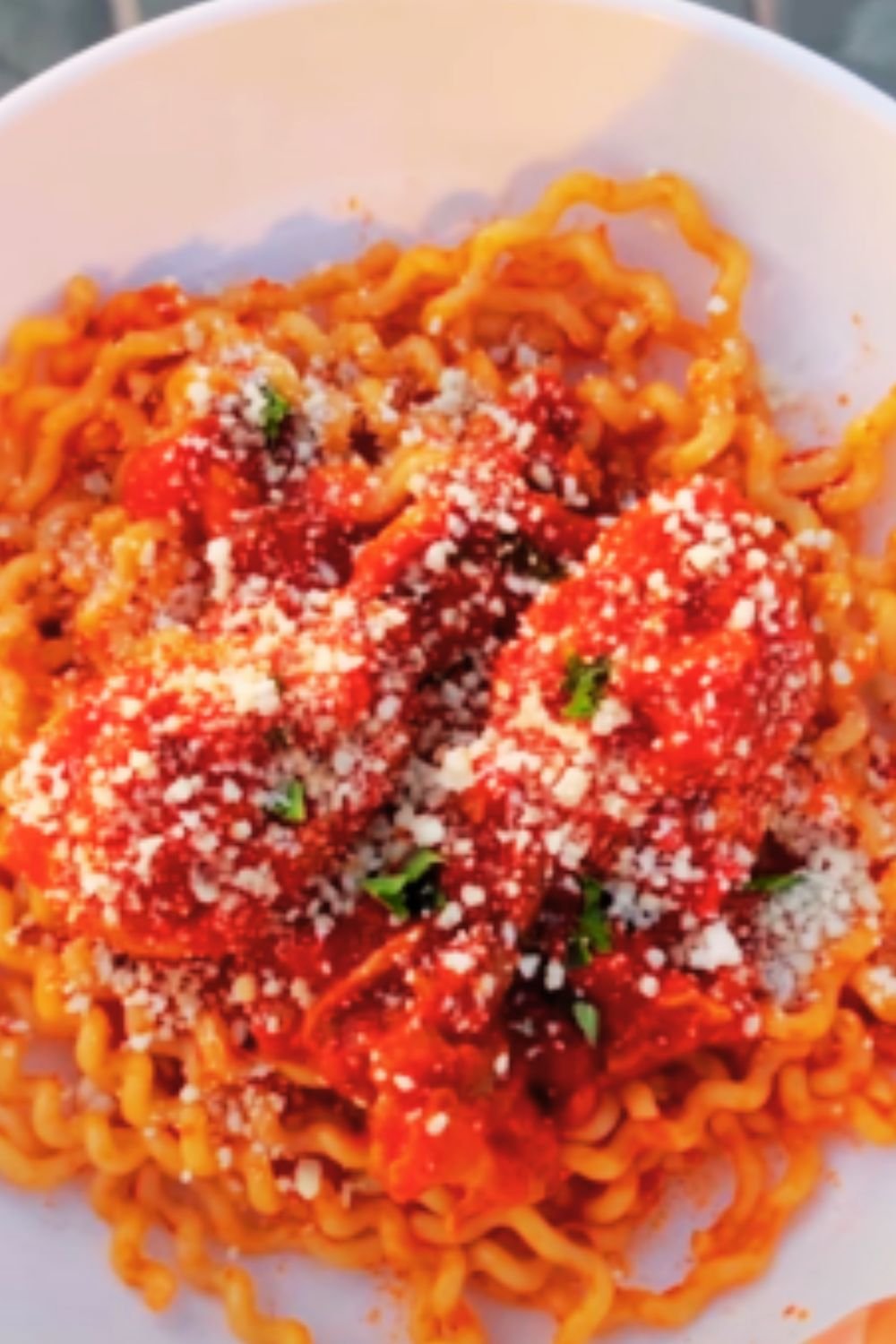There’s something truly magical about the aroma of Chicken Cacciatore simmering on the stove. The rich tomato sauce, fragrant herbs, and tender chicken create a symphony of flavors that transport me straight to the Italian countryside. As someone who has been cooking this dish for over two decades, I’ve perfected my recipe through countless iterations, and today I’m thrilled to share my ultimate version with you.
Chicken Cacciatore, or “Hunter’s Chicken,” originated in central Italy as a rustic, hearty meal prepared after a successful hunt. What I love most about this dish is how it transforms humble ingredients into something extraordinary. The slow-cooked chicken becomes incredibly tender, while the sauce develops deep, complex flavors that will have everyone asking for seconds.
A Brief History of Chicken Cacciatore
Before diving into the recipe, let’s take a moment to understand the roots of this beloved dish. “Cacciatore” means “hunter” in Italian, and this preparation style dates back to the Renaissance period. Hunters would cook their fresh catch with whatever ingredients they had available—typically tomatoes, onions, herbs, and sometimes wine.
What started as a rustic meal has evolved into a cherished classic that varies from region to region in Italy. In northern Italy, white wine is often used, while southern Italian versions typically feature red wine and sometimes spicy peppers. My recipe draws inspiration from the central Italian tradition, with a few personal touches I’ve developed over the years.
Essential Ingredients
The beauty of Chicken Cacciatore lies in its relatively simple ingredient list. Here’s what you’ll need to create this Italian masterpiece:
For the Chicken
- 8 bone-in, skin-on chicken thighs (about 3 pounds)
- 1 teaspoon kosher salt
- 1/2 teaspoon freshly ground black pepper
- 2 tablespoons extra-virgin olive oil
- 1 tablespoon unsalted butter
For the Cacciatore Sauce
- 1 large yellow onion, diced
- 2 medium carrots, finely diced
- 2 celery stalks, finely diced
- 6 garlic cloves, minced
- 2 red bell peppers, sliced into strips
- 8 ounces cremini mushrooms, sliced
- 1/4 cup all-purpose flour
- 1 cup dry white wine (I prefer Pinot Grigio)
- 1 can (28 oz) San Marzano whole tomatoes, crushed by hand
- 1/4 cup tomato paste
- 2 bay leaves
- 3 sprigs fresh rosemary
- A handful of fresh thyme sprigs
- 2 tablespoons fresh oregano, chopped (or 2 teaspoons dried)
- 1/2 teaspoon red pepper flakes (optional)
- 1 cup chicken stock
- 1/3 cup kalamata olives, pitted and halved
- 1/4 cup capers, drained and rinsed
- 1/4 cup fresh basil, chopped
Equipment You’ll Need
Setting yourself up for success starts with having the right tools. Here’s what I recommend:
- Large Dutch oven or heavy-bottomed pot with lid
- Sharp chef’s knife
- Cutting board
- Wooden spoon
- Measuring cups and spoons
- Kitchen tongs
- Meat thermometer

Step-by-Step Preparation
Now let’s break down the cooking process into manageable steps. Follow these carefully, and you’ll have a remarkable Chicken Cacciatore on your table.
Step 1: Preparing the Chicken
- Pat the chicken thighs dry with paper towels to ensure proper browning.
- Season both sides generously with salt and pepper.
- Heat olive oil and butter in a Dutch oven over medium-high heat until shimmering.
- Working in batches to avoid overcrowding, place chicken skin-side down in the pot.
- Brown the chicken for 5-6 minutes on each side until golden.
- Transfer browned chicken to a plate and set aside.
Step 2: Building the Base Flavors
- In the same pot with the rendered chicken fat, add the diced onions, carrots, and celery.
- Sauté for 5-7 minutes until the vegetables begin to soften.
- Add the minced garlic and cook for another 30 seconds until fragrant.
- Stir in the sliced bell peppers and mushrooms, cooking for another 5 minutes until they begin to soften.
- Sprinkle the flour over the vegetables and stir continuously for 1-2 minutes to cook out the raw flour taste.
Step 3: Creating the Sauce
- Pour in the white wine, scraping the bottom of the pot with a wooden spoon to release any browned bits (this is where tremendous flavor lives!).
- Allow the wine to simmer for 2-3 minutes until slightly reduced.
- Add the hand-crushed tomatoes with their juice, tomato paste, bay leaves, rosemary, thyme, oregano, and red pepper flakes if using.
- Pour in the chicken stock and stir to combine all ingredients thoroughly.
- Bring the sauce to a gentle simmer.
Step 4: The Slow Cook
- Return the browned chicken to the pot, skin-side up, nestling the pieces into the sauce without submerging them completely.
- Reduce heat to low, cover the pot, and simmer for 40-45 minutes until the chicken is tender and reaches an internal temperature of 175°F.
- Halfway through cooking, gently stir the sauce around (not disturbing the chicken) to ensure even cooking.
Step 5: Finishing Touches
- Once the chicken is tender, add the olives and capers to the pot.
- Simmer uncovered for an additional 10 minutes to allow the sauce to thicken slightly.
- Remove the bay leaves, rosemary, and thyme sprigs.
- Taste the sauce and adjust seasoning with additional salt and pepper if needed.
- Just before serving, sprinkle fresh chopped basil over the dish.
Common Mistakes to Avoid
Even experienced cooks can fall into these traps when preparing Chicken Cacciatore. Here are some pitfalls to avoid:
- Not patting the chicken dry: This prevents proper browning and can result in steamed rather than seared chicken.
- Overcrowding the pot when browning: This lowers the temperature too much, preventing that gorgeous golden crust from forming.
- Using boneless, skinless chicken: The bones and skin add tremendous flavor and help keep the meat moist during the long cooking process.
- Rushing the cooking process: Cacciatore is meant to be cooked slowly to develop its signature robust flavors.
- Using low-quality canned tomatoes: San Marzano tomatoes truly make a difference in the final flavor profile.
- Overcomplicating the dish: Cacciatore’s beauty lies in its rustic simplicity.
Nutritional Information
For those keeping track of their nutritional intake, here’s a breakdown of what you can expect per serving (based on 8 servings):
| Nutrient | Amount per Serving |
|---|---|
| Calories | 465 |
| Protein | 38g |
| Fat | 24g |
| Saturated Fat | 7g |
| Carbohydrates | 15g |
| Fiber | 3g |
| Sugar | 6g |
| Sodium | 720mg |
| Cholesterol | 145mg |
| Vitamin A | 45% DV |
| Vitamin C | 85% DV |
| Calcium | 6% DV |
| Iron | 15% DV |
Regional Variations
One of the fascinating aspects of Chicken Cacciatore is how it varies across different regions of Italy. Here’s a look at some of these delicious variations:
| Region | Characteristic Ingredients | Cooking Method | Serving Style |
|---|---|---|---|
| Tuscany | Fresh herbs, white wine, minimal tomato | Slow-braised | Served with crusty bread |
| Sicily | Red wine, olives, capers, chili peppers | Long simmer | Over polenta |
| Lombardy | Mushrooms, white wine, sage | One-pot braise | With risotto |
| Umbria | Game birds, rosemary, juniper berries | Hunter-style slow cook | With roasted potatoes |
| Naples | San Marzano tomatoes, peppers, oregano | Long, slow simmer | With pasta |
Serving Suggestions

Chicken Cacciatore is incredibly versatile when it comes to serving options. Here are my favorite ways to enjoy this classic dish:
- Over polenta: The creamy texture of polenta creates the perfect backdrop for the rich sauce.
- With pasta: Pappardelle or fettuccine work particularly well, catching the chunky sauce in their wide strands.
- Alongside roasted potatoes: Crispy roasted potatoes with rosemary complement the tender chicken beautifully.
- With crusty Italian bread: Perfect for sopping up every last bit of that delicious sauce.
- Over creamy mashed potatoes: For the ultimate comfort food experience.
- With steamed green vegetables: Asparagus or broccolini provide a nice textural contrast and add color to the plate.
- Accompanied by a simple arugula salad: The peppery greens balance the richness of the dish.
I personally prefer serving it over creamy polenta with a side of sautéed spinach for a complete meal that never fails to impress dinner guests.
Make-Ahead and Storage Tips
One of the many virtues of Chicken Cacciatore is that it actually improves with time as the flavors meld together. Here’s how to make the most of this characteristic:
Make-Ahead Options
- Prepare the entire dish up to 2 days ahead and refrigerate. The flavors will deepen beautifully.
- You can also prepare the sauce separately up to 3 days ahead, then complete the dish with the chicken when ready to serve.
Storage Guidelines
- Refrigeration: Store leftovers in an airtight container for up to 4 days.
- Freezing: Chicken Cacciatore freezes exceptionally well for up to 3 months. Cool completely before transferring to freezer-safe containers.
Reheating Instructions
- Stovetop: Gently reheat over medium-low heat, adding a splash of chicken stock if the sauce has thickened too much.
- Oven: Cover with foil and reheat at 325°F for about 20 minutes or until heated through.
- Microwave: Use 50% power in 1-minute increments, stirring between each, until heated through.
Adapting for Dietary Needs
This classic recipe can be modified to accommodate various dietary requirements without sacrificing its essential character:
| Dietary Need | Modification | Flavor Impact |
|---|---|---|
| Gluten-free | Omit flour or use rice flour/cornstarch | Minimal change in texture |
| Dairy-free | Replace butter with olive oil | Slightly less richness |
| Low-carb | Serve with cauliflower rice or mash | Maintains integrity of the dish |
| Vegetarian | Substitute mushrooms, eggplant, and artichokes for chicken | Different but equally delicious |
| Less spicy | Omit red pepper flakes | Milder flavor profile |
| Lower sodium | Reduce salt, use low-sodium broth | Adjust with herbs for flavor |

Chef’s Tips for Perfect Cacciatore
After years of making this dish, I’ve discovered several techniques that elevate it from good to extraordinary:
- Use chicken thighs: They’re more flavorful and remain tender during long cooking, unlike breast meat which can become dry.
- Don’t rush the browning: That golden crust on the chicken develops incredible depth of flavor that forms the foundation of the entire dish.
- Layer the aromatics: Adding ingredients in stages—starting with onions, then garlic, then herbs—creates a complex flavor profile.
- Hand-crush tomatoes: This creates a rustic texture with both chunks and smooth sauce, characteristic of authentic cacciatore.
- Keep the skin on: The chicken skin renders fat that enriches the sauce and helps keep the meat moist during cooking.
- Let it rest: If possible, make the cacciatore a day ahead and reheat. The flavors will be noticeably improved.
- Fresh herbs at the end: Adding a sprinkle of fresh basil or parsley just before serving brightens the whole dish.
Frequently Asked Questions
Q: Can I use chicken breasts instead of thighs? While you can use breasts, they tend to dry out during the long cooking process. If you prefer white meat, I recommend using bone-in, skin-on chicken breasts and reducing the cooking time to about 30 minutes.
Q: Is it necessary to use wine in this recipe? The wine adds depth and acidity that helps balance the richness of the dish. If you prefer not to use alcohol, substitute with an equal amount of chicken stock plus 1 tablespoon of white wine vinegar.
Q: Can I make this in a slow cooker? Absolutely! Brown the chicken and sauté the vegetables as directed, then transfer everything to a slow cooker. Cook on low for 6-7 hours or on high for 3-4 hours.
Q: What’s the difference between Chicken Cacciatore and Chicken Marsala? While both are Italian chicken dishes, Marsala features a wine sauce made with Marsala wine and typically includes mushrooms but no tomatoes. Cacciatore has a tomato-based sauce with a variety of vegetables.
Q: How can I thicken the sauce if it’s too watery? Remove the chicken pieces temporarily, then simmer the sauce uncovered for 10-15 minutes until it reduces to your desired consistency.
Q: Can I add other vegetables to the recipe? Certainly! Fennel, zucchini, or yellow squash make excellent additions. Add these about halfway through the cooking process to prevent them from becoming too soft.
Q: Is Chicken Cacciatore spicy? Traditional cacciatore is not particularly spicy, but the red pepper flakes in my recipe add a gentle warmth. Adjust or omit according to your preference.
Why This Recipe Works
Having refined this recipe over many years, I can confidently say it captures the essence of what makes Chicken Cacciatore so beloved. Here’s why this particular approach succeeds:
- The technique of browning the chicken first creates a foundation of flavor that permeates the entire dish.
- Using bone-in, skin-on chicken pieces ensures the meat remains juicy and tender throughout the cooking process.
- The combination of aromatics (onion, carrot, celery, garlic) provides a classical Italian flavor base that supports the other ingredients.
- San Marzano tomatoes offer a sweet-acidic balance that regular tomatoes simply can’t match.
- The addition of olives and capers provides pops of briny flavor that cut through the richness of the sauce.
- Allowing ample cooking time gives the flavors an opportunity to meld and develop complexity.
The result is a Chicken Cacciatore that honors its rustic origins while elevating the dish to something truly special—comfort food that’s simultaneously sophisticated and soul-satisfying.

Final Thoughts
Chicken Cacciatore epitomizes what I love most about Italian cooking—transforming simple ingredients through thoughtful preparation into something greater than the sum of its parts. The dish has stood the test of time for good reason.
Whether you’re preparing it for a casual family dinner or a special occasion with friends, this recipe offers the perfect balance of accessibility and impression. The aromas that fill your kitchen as it simmers will create anticipation, and the rich, complex flavors will not disappoint.
I encourage you to make this recipe your own over time. Perhaps you’ll prefer more garlic or an extra splash of wine. Maybe you’ll discover that a pinch of saffron or a spoonful of anchovy paste adds that certain je ne sais quoi. That’s the beauty of cooking—recipes evolve and become part of our personal culinary heritage.
So gather your ingredients, set aside a leisurely afternoon, and prepare to experience the magic of Chicken Cacciatore. I promise it will become a treasured addition to your repertoire of comfort food classics.


